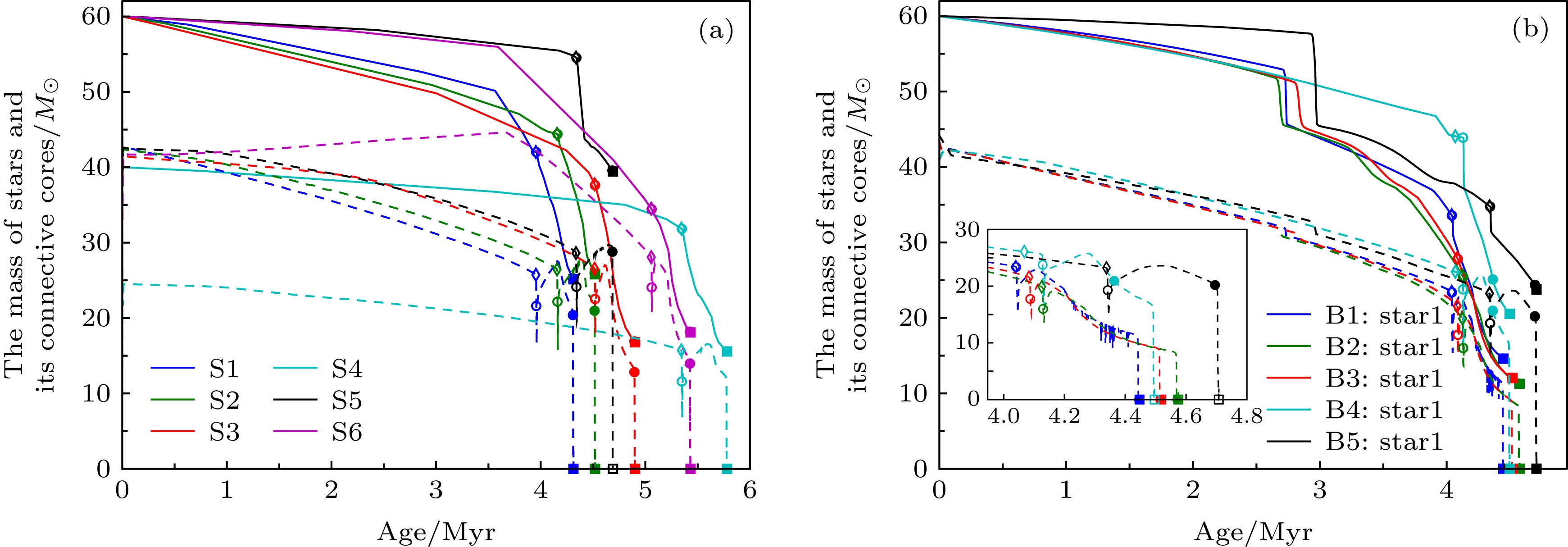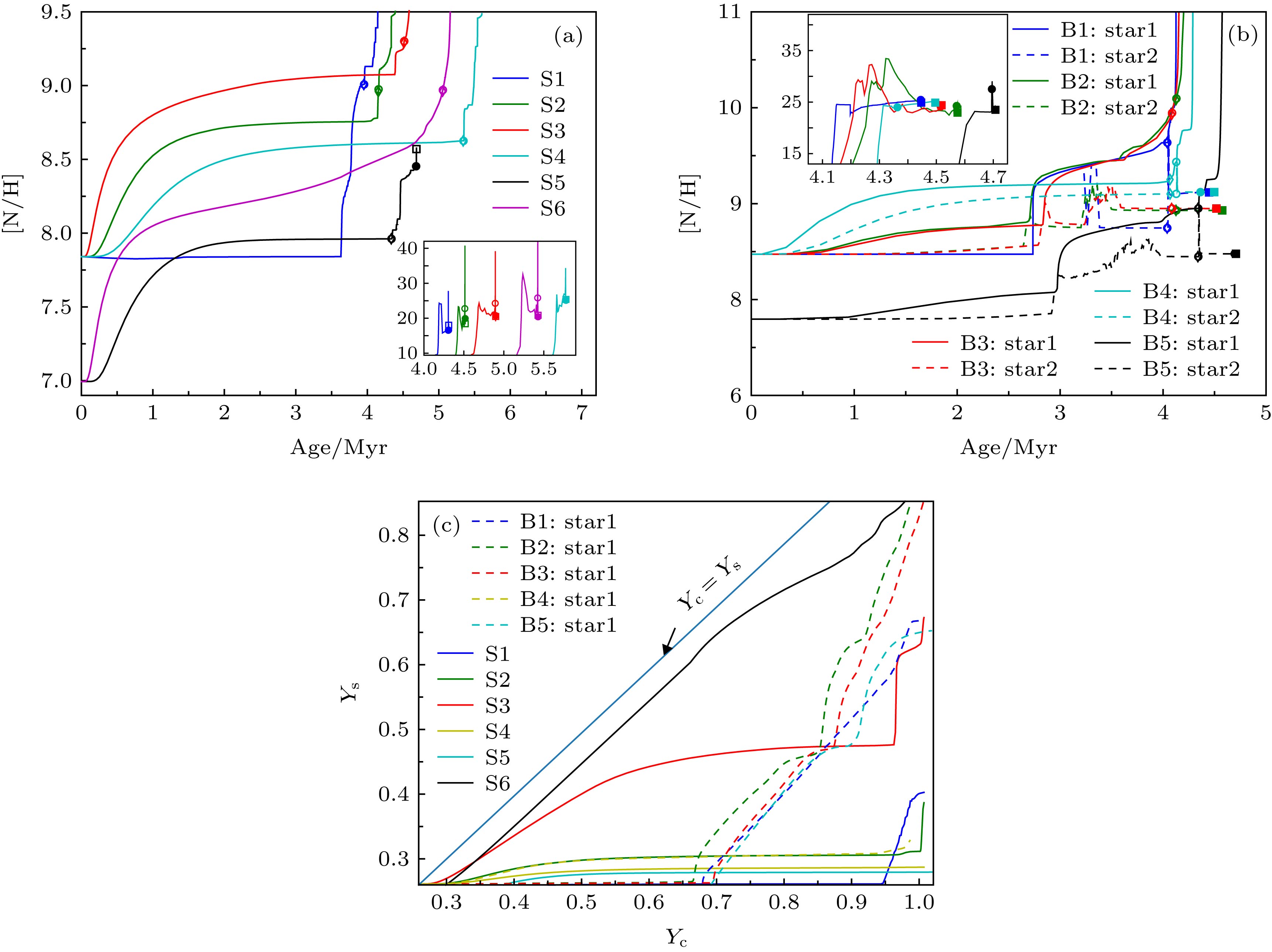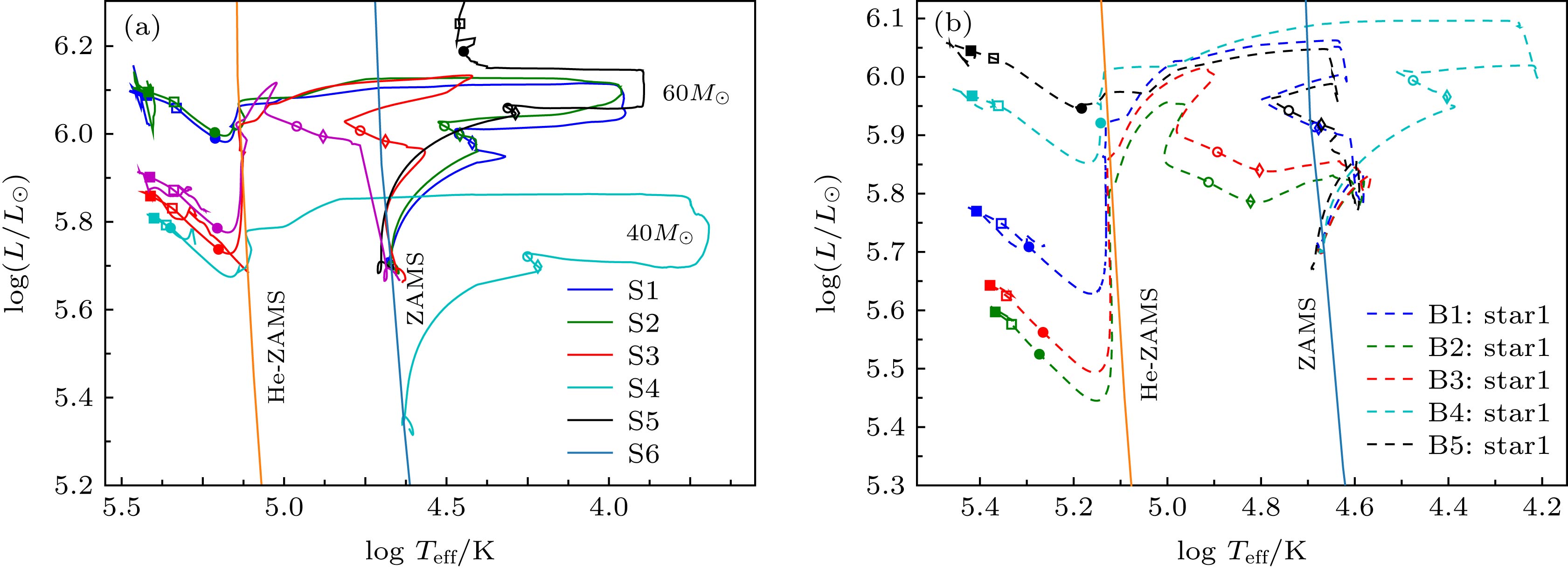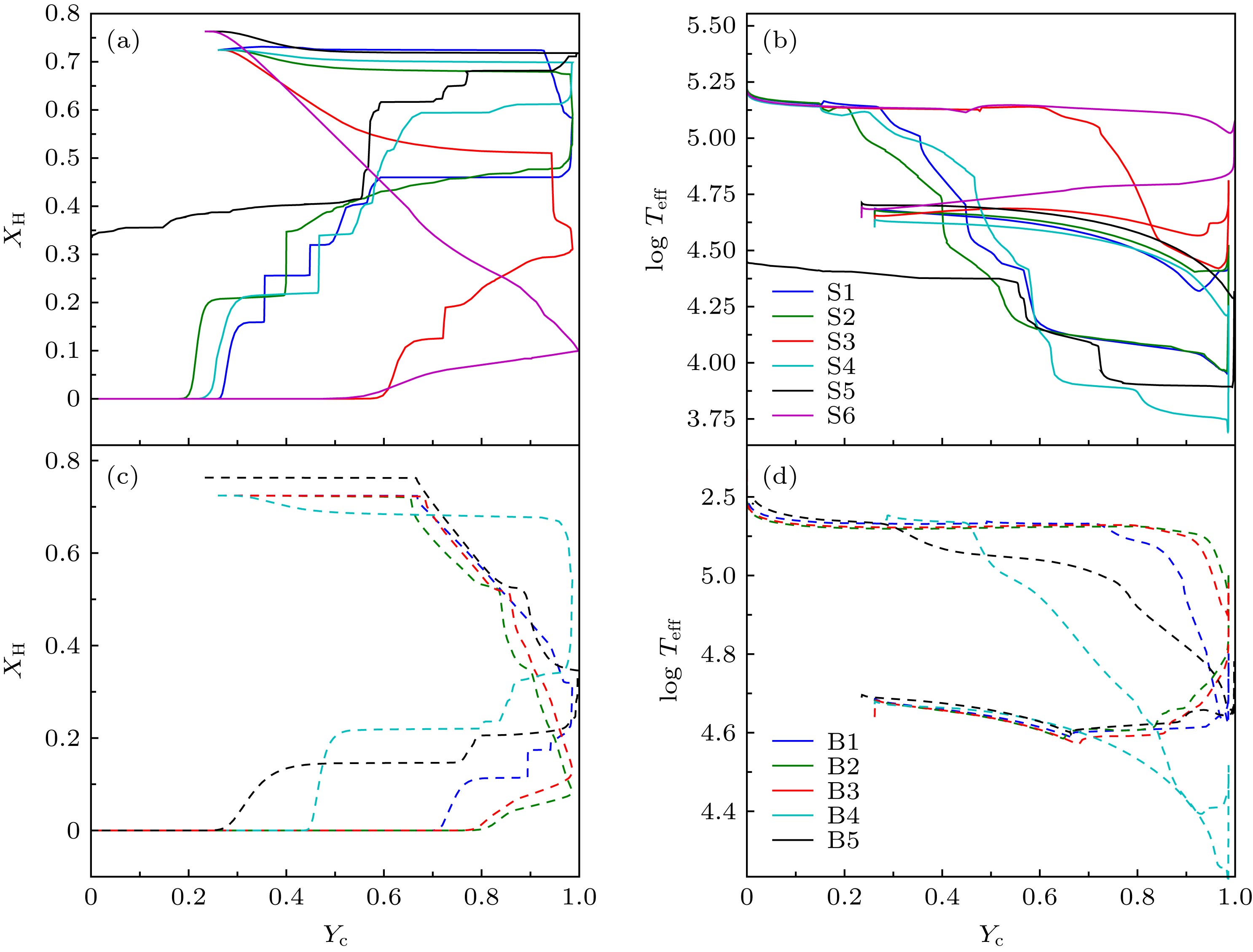-
Wolf-Rayet stars (WR stars) were discovered by French astronomers Charles Wolf and Georges Rayet in 1867. The Wolf-Rayet (WR) stars are the evolved descents of the most massive, extremely hot (temperatures up to 200000 K) and very luminous (105
$ L_{\odot} $ -106$L_{\odot}$ ) O stars, with 25$ M_{\odot} $ -30$M_{\odot}$ solar mass for solar metallicity. The WR stars possess very strong stellar winds, which have velocities up to 3000 km/s and wind mass loss rate$10^{-5} M_{\odot}$ a year. These winds are observed in the broad emission line profiles (sometimes, even P-Cygni profiles) of WR spectra in the optical and UV range. Actually, these winds are so strong that they can peel the star and convert it into a nude nucleus without envelope. It has been found that three bright galactic stars located at Cygnus region have broad strong emission bands, rather than absorptions lines, superposed on the typical continuum of hot stars. In 1930 Beals correctly identified these features as emission lines produced by high ionized elements such as helium, carbon, nitrogen and oxygen. The physical factors which can affect the evolution of WR stars are explored in this paper. These physical factors include stellar mass, initial velocities, orbital periods, metallicities, etc. According to the equations for angular momentum transfer and chemical element diffusion, we can ascertainhow these physical factors influence the evolution of WR stars and the mixing of chemical elements in WR stars.The result indicates that massive stars with high initial velocities and metallicities have strong stellar winds and be prone to producing WR stars. In contrast with the counterpart with high metallicities,it is hard for the single star with low metallicity to generate WR star due to weak wind. However, the star with very high initial velocity and low metallicity can form chemical homogenious evolution. Thestar has an enlarged convective core and a very thin hydrogen envelope and it can also generate WR star. The component in the binary system with short orbital period can transfer mass to the companion star through Roche lobe overflow, and this physical process can produce WR star under the condition of low metallicity. Furthermore, mass removal due to Roche lobe overflow reduces the temperature of stellar convective core and rate of nuclear reaction. It is shown that mass metallicities of chemical elements including 4He, 12C, 19F, 22Ne, 23Na, 25Mg in the primary star are higher than those in the single stars, whereas mass metallicities of chemical elements including 1H, 14N, 16O, 20Ne, and 26Al are lower than those in the single counterparts. In a word, the conditions for massive stars with high initial velocities and metallicities in the binary system with short orbital period favor the formation of WR stars.-
Keywords:
- close binaries /
- evolution /
- rotation /
- tide
[1] Wolf C J E, Rayet G 1867 Academie des Sciences Paris Comptes Rendus 65 292
[2] Georgy C, Ekstrom S, Meynet G, Massey P, Levesque E M, Hirschi R, Eggenberger P, Maeder A 2012 Astron. Astrophys. 542 A29
 Google Scholar
Google Scholar
[3] Groh J H, Meynet G, Georgy C, Ekstrom S 2013 Astron. Astrophys. 558 A131
 Google Scholar
Google Scholar
[4] Eldridge J J, Fraser M, Smartt S J, Maund J R, Crockett R M 2013 Mon. Not. R. Astron. Soc. 436 774
 Google Scholar
Google Scholar
[5] Vuissoz C, Meynet G, Kndlseder J, Cervino M, Schearer D, Palacios A, Mowlavi N 2004 New Astron. Rev. 48 7
 Google Scholar
Google Scholar
[6] 黄润乾 2006 恒星物理 (第2版) (北京: 中国科学技术出版社) 第378−384页
Huang R Q 2006 Stellar Physics (2nd Ed.) (Beijing: Science and Technology of China Press) pp378−384 (in Chinese)
[7] Paczynski B 1971 Annu. Rev. Astron. Astrophys. 9 183
 Google Scholar
Google Scholar
[8] Huang R Q 2004 Astron. Astrophys. 422 981
 Google Scholar
Google Scholar
[9] Huang R Q 2004 Astron. Astrophys. 425 591
 Google Scholar
Google Scholar
[10] Kippenhahn R, Thomas H C 1969 Mitt. A. G. 27 168
[11] Endal A S, Sofia S 1976 Astrophys. J. 210 184
 Google Scholar
Google Scholar
[12] Pinsonneault M H, Kawaler S D, Sofia S, Demarque P 1989 Astrophys. J. 338 424
 Google Scholar
Google Scholar
[13] Pinsonneault M H, Kawaler S D, Demarque P 1990 Astrophys. J. Suppl. Ser. 74 501
 Google Scholar
Google Scholar
[14] Pinsonneault M H, Deliyannis C P, Demarque P 1991 Astrophys. J. 367 239
 Google Scholar
Google Scholar
[15] 宋汉峰, 王靖洲, 李云 2013 物理学报 62 059701
 Google Scholar
Google Scholar
Song H F, Wang J Z, Li Y 2013 Acta Phys. Sin. 62 059701
 Google Scholar
Google Scholar
[16] Song H F, Wang J Z, Song F, Song F, Wang J T 2017 Astron. Astrophys. 600 A42
 Google Scholar
Google Scholar
[17] 詹琼, 宋汉峰, 邰丽婷, 王江涛 2015 物理学报 64 089701
 Google Scholar
Google Scholar
Zhan Q, Song H F, Tai L T, Wang J T 2015 Acta Phys. Sin. 64 089701
 Google Scholar
Google Scholar
[18] 邰丽婷, 宋汉峰, 王江涛 2016 物理学报 65 049701
 Google Scholar
Google Scholar
Tai L T, Song H F, Wang J T 2016 Acta Phys. Sin. 65 049701
 Google Scholar
Google Scholar
[19] Zahn J P 1975 Astron. Astrophys. 41 329
[20] Zahn J P 1977 Astron. Astrophys. 57 383
[21] Maeder A, Meynet G 2000 Annu. Rev. Astron. Astrophys. 38 143
 Google Scholar
Google Scholar
[22] de Mink S E, Cantiello M, Langer N, Pols O R, Brott I, Yoon S C 2009 Astron. Astrophys. 497 243
 Google Scholar
Google Scholar
[23] Song H F, Meynet G, Maeder A, Ekstrom S, Eggenberger P 2016 Astron. Astrophys. 585 A120
 Google Scholar
Google Scholar
[24] Maeder A 1987 Astron. Astrophys. 178 159
[25] Wang J T, Song H F 2016 Chin. Phys. Lett. 33 099702
 Google Scholar
Google Scholar
[26] Li Z, Song H F, Peng W G 2018 Chin. Phys. Lett. 35 079701
 Google Scholar
Google Scholar
[27] Meynet G, Maeder A 1997 Astron. Astrophys. 321 465
[28] Endal A S, Sofia S 1978 Astrophys. J. 220 279
 Google Scholar
Google Scholar
[29] Kippenhahn R 1974 Late Stages of Stellar Evolution (Warsaw: D Reidel Publishing Co) p20
[30] Heger A, Langer N, Woosley S E 2000 Astrophys. J. 528 368
 Google Scholar
Google Scholar
[31] Vink J S, de Koter A, Lamers H J G L M 2000 Astron. Astrophys. 362 295
[32] Vink J S, de Koter A, Lamers H J G L M 2001 Astron. Astrophys. 369 574
 Google Scholar
Google Scholar
[33] Nugis T, Lamers H J G L M 2000 Astron. Astrophys. 360 227
[34] Eldridge J J, Vink J S 2006 Astron. Astrophys. 452 295
 Google Scholar
Google Scholar
[35] Paxton B, Bildsten L, Dotter A, Herwig F, Lesaffre P, Timmes F 2011 Astrophys. J. Suppl. 192 3P
 Google Scholar
Google Scholar
[36] Paxton B, Cantiello M, Arras P, Bildsten L, Brown E F, Dotter A, Mankovich C, Montgomery M H, Stello D, Timmes F X, Townsend R 2013 Astrophys. J. Suppl. 208 4P
 Google Scholar
Google Scholar
[37] Paxton B, Marchant P, Schwab J, Bauer E B, Bildsten L, Cantiello M, Dessart L, Farmer R, Hu H, Langer N, Townsend R H D, Townsley D M, Timmes F X 2015 Astrophys. J. Suppl. 220 15P
 Google Scholar
Google Scholar
[38] Meynet G, Maeder A 2002 Astron. Astrophys. 381 25
 Google Scholar
Google Scholar
-
图 1 (a)单星模型赤道转动速度随时间的变化; (b)双星模型赤道转动速度随时间的变化; 其中, 空心菱形为主序结束, 空心圆圈为中心氦开始燃烧, 实心圆圈为中心氦燃烧结束, 空心正方形为中心碳开始燃烧, 实心正方形是中心碳燃烧结束
Figure 1. (a) Variations of equatorial velocity in single star models; (b) variations of equatorial velocity in binary star models. Hollow diamonds denote the end of main sequence; hollow circles stand for the beginning of helium burning; solid circles denote the end of helium burning; hollow squares represent the beginning of carbon burning; solid squares represent the end of carbon burning
图 2 (a) 各种单星模型的质量(实线)和其对应的对流核的质量(划线)随时间的变化; (b) 各种双星模型的质量(实线)和其对应的对流核的质量(划线)随时间的变化
Figure 2. (a) Stellar mass and its mass of convective core vary with evolutionary time for the models of single star; (b) stellar mass and its mass of convective core vary with evolutionary time for the models of binary star
图 3 (a)单星模型中恒星表面氮丰度随时间的演化; (b)双星模型中两子星表面氮丰度随时间的演化; (c) 主序阶段, 单星和双星模型的表面氦质量丰度随中心氦质量丰度的变化
Figure 3. (a) Surface nitrogen abundance vary with evolutionary time for the models of single star; (b) surface nitrogen abundance vary with evolutionary time for the models of binary star; (c) surface helium abundance vary with central helium for the models of single stars and binary star
图 4 (a) 单星非转动S1模型表面各种元素的质量丰度的对数值随时间的演化; (b) 单星转动S6模型表面各种元素的质量丰度的对数值随时间的演化; (c) 双星非转动B1模型中的主星表面各种元素的质量丰度的对数值随时间的演化; (d) 双星转动模型B2中的主星表面各种元素的质量丰度的对数值随时间的演化
Figure 4. (a) Evolution as a function of the actual mass of the abundances (in mass fraction) of different elements at the surface of a non-rotating single model S1; (b) evolution as a function of the actual mass of the abundances (in mass fraction) of different elements at the surface of a rotating single model S6; (c) evolution as a function of the actual mass of the abundances (in mass fraction) of different elements at the surface of the primary star of model B1; (d) evolution as a function of the actual mass of the abundances (in mass fraction) of different elements at the surface of the primary star of model B2
图 7 (a) 单星模型表面氢的质量丰度随中心氦质量丰度的变化; (b) 单星模型表面有效温度随中心氦质量丰度的变化; (c) 双星模型表面氢的质量丰度随中心氦质量丰度的变化; (d) 双星模型表面有效温度随中心氦质量丰度的变化
Figure 7. (a) Surface mass fraction of hydrogen varies with central helium mass fraction in models of single star; (b) surface effective temperature varies with central helium mass fraction in models of single star; (c) surface mass fraction of hydrogen varies with central helium mass fraction in models of binary star; (d) surface effective temperature varies with central helium mass fraction in models of of binary star
表 1 WR星分类的判定依据
Table 1. Criteria for classification of WR stars
0.45 WR星的类型 判定依据 O型星 $\log (T_{\rm eff})>4.5$ WNL型星 $\log (T_{\rm eff})>4.0$ 和 $X_{\rm H} <0.3$ WNE型星 $X_{\rm H} <10^{-5}$ 和 $X_{\rm C}<X_{\rm N}$ WNC型星 $\dfrac{X_{\rm C}}{X_{\rm N}}>0.1$ 和 $\dfrac{X_{\rm C}}{X_{\rm N}}<10$ WC型星 $X_{\rm C}>X_{\rm N}$ 和 $\rm \dfrac{C+O}{He}<1$ WO型星 $X_{\rm C}>X_{\rm N}$ 和 $\rm \dfrac{C+O}{He}>1$ 注: $T_{\rm eff}$是恒星的有效温度; ${X_{i} }/{X_{j} }$为恒星元素的质量丰度之比; $\rm ({C+O})/{He}$为数丰度之比. 表 2 单星和双星理论模型的初始参数
Table 2. Initial parameters for single stars and binaries
Models $M_1/M_\odot$ $M_2/M_\odot$ $Z$ $\alpha$ $P_{\rm orb, ini}$/d $V_{\rm ini, 1}$/km·s–1 $V_{\rm ini, 2}$/km·s–1 S1 60 — 0.014 0.0385 — 0 — S2 60 — 0.014 0.0385 — 300 — S3 60 — 0.014 0.0385 — 600 — S4 40 — 0.014 0.0385 — 300 — S5 60 — 0.0021 0.0385 — 300 — S6 60 — 0.0021 0.0385 — 600 — B1 60 40 0.014 0.0385 3.0 0 0 B2 60 40 0.014 0.0385 3.0 300 300 B3 60 40 0.014 0.0385 3.0 600 600 B4 60 40 0.014 0.0385 40.0 300 300 B5 60 40 0.0021 0.0385 3.0 300 300 注: B为双星系统, S为单星; $M_1$, $M_2$分别为主星和次星的质量(以太阳质量$M_{\odot}$为单位); Z为金属丰度; $\alpha$为对流超射系数;
$P_{\rm orb, ini}$为双星初始轨道周期; $V_{\rm ini, 1}$, $V_{\rm ini, 2}$分别为主星和次星的初始自转赤道速度.表 3 单星模型在各个演化阶段的参数
Table 3. Parameters for single star at different evolutionary stages
Sequence Age/Myr $M/M_{\odot}$ $\log T_{\rm eff}$ $\log ({L_{1}}/{L_{\odot}})$ $\rm [N/H]$ $V_{\rm eq}$/km·s–1 $\log T_{\rm c}$ $\log \rho_{\rm c}$ ZAMS S1 0.0000 60.00 4.68 5.72 7.84 0.00 7.60 0.31 S2 0.0000 60.00 4.66 5.70 7.84 300.00 7.59 0.29 S3 0.0000 60.00 4.63 5.64 7.84 600.00 7.58 0.26 S4 0.0000 40.00 4.62 5.34 7.84 300.00 7.57 0.40 S5 0.0000 60.00 4.67 5.74 6.99 300.00 7.57 0.24 S6 0.0000 60.00 4.65 5.70 6.99 600.00 7.56 0.21 TAMS S1 3.9511 42.02 4.42 5.98 9.01 0.00 7.81 0.91 S2 4.1537 44.42 4.46 6.00 8.96 18.07 7.81 0.90 S3 4.5124 37.75 4.69 5.98 9.29 18.66 7.81 0.92 S4 5.3408 31.87 4.22 5.70 8.63 1.42 7.79 1.00 S5 4.3346 54.56 4.29 6.05 7.96 7.21 7.87 1.05 S6 5.0531 34.52 4.88 5.99 8.96 25.65 7.86 1.10 BCHEB S1 3.9550 42.01 4.46 6.00 9.01 0.00 7.98 1.43 S2 4.1574 44.40 4.51 6.02 8.98 19.75 7.98 1.42 S3 4.5162 37.62 4.77 6.01 9.30 25.72 7.98 1.45 S4 5.3453 31.83 4.25 5.72 8.63 1.37 7.96 1.51 S5 4.3383 54.53 4.31 6.06 7.96 7.28 8.03 1.55 S6 5.0570 34.44 4.96 6.02 8.97 36.78 8.03 1.60 ECHEB S1 4.3054 25.27 5.21 5.99 23.45 0.00 8.53 3.13 S2 4.5120 25.94 5.21 6.00 23.02 158.64 8.53 3.13 S3 4.8924 16.90 5.20 5.74 24.64 76.49 8.51 3.22 S4 5.7771 15.57 5.35 5.79 25.17 327.58 8.88 4.59 S5 4.6825 39.56 4.45 6.19 8.45 5.98 8.54 3.07 S6 5.4231 18.20 5.21 5.79 28.82 49.92 8.52 3.21 BCCB S1 4.3099 25.16 5.33 6.06 16.72 0.00 8.83 4.14 S2 4.5167 25.81 5.34 6.07 19.18 286.44 8.85 4.24 S3 4.8980 16.80 5.34 5.83 20.60 149.13 8.86 4.45 S4 5.7772 15.57 5.36 5.79 25.28 334.92 8.92 4.78 S5 4.6870 39.45 4.46 6.25 8.57 37.32 8.84 4.12 S6 5.4284 18.10 5.34 5.87 20.66 94.78 8.85 4.35 ECCB S1 4.3100 25.15 5.42 6.09 18.59 0.00 9.07 5.25 S2 4.5167 25.81 5.42 6.10 18.47 313.57 9.06 5.19 S3 4.8981 16.80 5.41 5.86 20.55 157.94 9.06 5.40 S4 5.7772 15.57 5.40 5.81 25.43 367.73 9.03 5.33 S5 — — — — — — — — S6 5.4285 18.10 5.41 5.90 20.90 97.57 9.05 5.34 注: ZAMS为零龄主序; TAMS表示主序结束; BCHEB为中心氦核开始燃烧; ECHEB为中心氦核结束燃烧; BCCB 为中心碳核开始燃烧; CCB为中心碳核结束燃烧. 表 4 双星模型在各个主要演化阶段的参数
Table 4. Evolutionary parameters for binary star at different stages.
Sequence Age
/Myr$P_{\rm orb}$
/d$M_{1}/M_{\odot}$ $M_{2}/M_{\odot}$ $\log(T_{\rm eff, 1})$
/K$\log \Big(\dfrac{L_{1}}{L_{\odot} }\Big)$ $\log(T_{\rm eff, 2})$
/K$\log \Big(\dfrac{L_{2}}{L_{\odot} }\Big)$ $\Big[\rm \dfrac{N_{1}}{H}\Big]$ $\Big[\rm \dfrac{N_{2}}{H}\Big]$ $V_{\rm eq1}$/
km·s–1$V_{\rm eq2}$/
km·s–1$\log T_{\rm c}$/
K$\log \rho_{\rm c}$/
g·cm–3ZAMS B1 0.0000 3.00 60.00 40.00 4.68 5.71 4.64 5.36 7.84 7.84 0.00 0.00 7.62 0.37 B2 0.0000 3.00 60.00 40.00 4.67 5.70 4.63 5.34 7.84 7.84 288.35 294.86 7.61 0.35 B3 0.0000 3.00 60.00 40.00 4.64 5.65 4.59 5.27 7.84 7.84 566.93 581.75 7.60 0.32 B4 0.0000 40.00 60.00 40.00 4.67 5.70 4.63 5.34 7.84 7.84 288.35 294.86 7.61 0.35 B5 0.0000 3.00 60.00 40.00 4.69 5.66 4.65 5.29 6.99 6.99 306.83 301.14 7.66 0.50 BTM1 B1 2.6862 3.60 53.01 38.15 4.59 5.84 4.59 5.48 7.84 7.84 0.00 0.00 7.64 0.39 B2 2.6314 3.63 51.90 38.00 4.59 5.82 4.59 5.47 8.25 7.94 250.24 162.73 7.63 0.39 B3 2.7810 4.12 51.34 37.86 4.57 5.83 4.59 5.48 8.22 7.96 238.80 146.79 7.64 0.40 B4 4.1328 63.17 43.82 35.94 4.23 6.02 4.49 5.56 9.05 8.69 35.18 120.39 8.24 2.26 B5 2.9131 3.25 57.69 39.46 4.60 5.86 4.61 5.47 7.34 7.07 270.95 164.95 7.68 0.52 ETM1 B1 3.8956 4.25 36.84 43.77 4.62 5.90 4.57 5.67 9.20 8.18 0.00 0.00 7.70 0.61 B2 2.7305 3.41 45.44 43.82 4.60 5.78 4.61 5.57 8.66 8.26 239.26 177.55 7.63 0.42 B3 2.9777 3.92 44.57 43.27 4.59 5.81 4.60 5.58 8.83 8.25 226.58 161.96 7.64 0.44 B4 4.1426 65.47 36.94 36.00 4.27 6.10 4.49 5.56 9.26 8.67 73.07 330.19 8.31 2.47 B5 3.9817 3.61 38.02 51.22 4.63 5.87 4.65 5.73 8.27 7.82 217.02 168.84 7.72 0.69 TAMS B1 4.0397 4.65 33.60 43.48 4.68 5.91 4.56 5.68 9.30 8.18 0.00 0.00 7.81 0.95 B2 4.1254 5.13 25.57 43.47 4.83 5.79 4.53 5.69 9.86 8.41 20.52 193.13 7.80 0.99 B3 4.0832 5.43 27.93 43.40 4.81 5.84 4.54 5.68 9.66 8.44 19.99 174.17 7.80 0.97 B4 4.0693 62.61 44.06 36.03 4.41 5.97 4.54 5.56 8.82 8.63 6.63 68.60 7.72 0.65 B5 4.3382 3.81 34.79 50.91 4.68 5.92 4.63 5.75 8.44 7.81 169.76 181.54 7.86 1.10 BCHEB B1 4.0409 4.65 33.57 43.48 4.69 5.91 4.56 5.68 9.30 8.18 0.00 0.00 7.82 0.99 B2 4.1297 5.15 25.44 43.46 4.92 5.82 4.53 5.69 9.87 8.41 30.07 192.49 7.97 1.52 B3 4.0874 5.45 27.80 43.39 4.90 5.87 4.54 5.68 9.68 8.44 29.48 173.40 7.98 1.50 B4 4.1281 63.03 43.88 35.95 4.48 5.99 4.53 5.56 9.04 8.63 4.75 60.68 7.91 1.21 B5 4.3422 3.82 34.74 50.91 4.75 5.94 4.63 5.76 8.44 7.81 149.04 181.17 8.02 1.60 BMT2 B1 4.0474 4.67 33.39 43.47 4.63 6.00 4.58 5.69 9.30 9.30 0.00 0.00 8.24 2.29 B2 3.1581 3.55 43.04 43.10 4.61 5.81 4.59 5.59 8.99 8.19 231.13 191.20 7.64 0.45 B3 3.1290 3.97 43.65 43.04 4.59 5.82 4.59 5.58 8.93 8.23 223.55 166.73 7.64 0.45 B4 — — — — — — — — — — — — — — B5 4.3460 3.84 34.70 50.90 4.66 5.99 4.63 5.76 8.44 7.81 187.54 180.93 8.26 2.34 EMT2 B1 4.0562 5.13 30.44 45.39 4.65 6.06 4.62 5.72 9.48 8.74 0.00 0.00 8.31 2.49 B2 3.5409 3.78 37.67 44.95 4.61 5.82 4.59 5.65 9.06 8.42 212.81 195.54 7.66 0.51 B3 3.6151 4.27 37.66 44.50 4.60 5.84 4.58 5.65 9.07 8.44 203.84 175.46 7.66 0.52 B4 — — — — — — — — — — — — — — B5 4.3517 4.25 31.33 51.54 4.67 6.05 4.64 5.77 8.60 7.91 174.27 292.23 8.31 2.49 ECHEB B1 4.4454 8.50 14.60 44.32 5.30 5.71 4.57 5.75 25.43 8.65 0.00 0.00 8.74 3.96 B2 4.5716 8.31 11.27 42.40 5.27 5.52 4.45 5.73 24.26 8.41 58.94 181.80 8.70 3.93 B3 4.5155 9.20 12.05 42.46 5.27 5.56 4.47 5.71 24.15 8.44 52.74 142.55 8.68 3.83 B4 4.3645 94.44 25.01 35.66 5.14 5.92 4.50 5.58 24.02 8.65 0.32 127.17 8.37 2.68 B5 4.6953 5.16 24.36 51.19 5.18 5.95 4.61 5.80 27.78 7.85 6.01 149.71 8.48 2.99 BCCB B1 4.4468 8.51 14.58 44.31 5.35 5.75 4.57 5.75 24.91 8.65 0.00 0.00 8.89 4.66 B2 4.5741 8.32 11.24 42.40 5.33 5.58 4.45 5.73 23.39 8.41 67.64 179.57 8.85 4.60 B3 4.5184 9.22 12.02 42.45 5.34 5.62 4.47 5.71 24.42 8.44 62.74 140.22 8.88 4.71 B4 4.4963 110.76 20.53 35.48 5.36 5.95 4.48 5.59 24.89 8.65 0.56 99.94 8.90 4.56 B5 4.7078 5.25 23.75 51.18 5.37 6.03 4.61 5.80 23.51 7.85 10.68 146.97 8.92 4.63 ECCB B1 4.4469 8.51 14.58 44.31 5.41 5.77 4.57 5.75 24.88 8.65 0.00 0.00 9.04 5.38 B2 4.5743 8.32 11.24 42.40 5.37 5.60 4.45 5.73 22.95 8.41 66.77 173.97 9.01 5.44 B3 4.5185 9.22 12.01 42.45 5.38 5.64 4.47 5.71 24.41 8.44 63.39 136.75 9.01 5.41 B4 4.4963 110.77 20.53 35.48 5.42 5.97 4.48 5.59 24.88 8.65 0.67 98.21 9.05 5.22 B5 4.7078 5.25 23.75 51.18 5.42 6.04 4.61 5.80 23.50 7.85 12.57 144.92 9.05 5.18 表 5 单星模型S1, S2和S6在各个主要阶段恒星表面的各种元素的质量丰度
Table 5. Mass fraction of various chemical elements at stellar surfaces at different stages in models S1, S2, and S6
Sequence Age/Myr $M_1/M_{\odot}$ log($X_{\rm ^{1}H}$) log($X_{\rm ^{4}He}$) log($X_{\rm ^{12}C}$) log($X_{\rm ^{14}N}$) log($X_{\rm ^{16}O}$) log($X_{\rm ^{19}F}$) log($X_{\rm ^{20}Ne}$) log($X_{\rm ^{22}Ne}$) $X_{\rm ^{26}Al}$ ZAMS S1 0.0000 60.00 –0.14 –0.58 –2.62 –3.15 –2.18 –6.46 –2.87 –3.96 0 S2 0.0000 60.00 –0.14 –0.58 –2.62 –3.15 –2.18 –6.46 –2.87 –3.96 0 S6 0.0000 60.00 –0.12 –0.63 –3.45 –3.98 –3.01 –7.28 –3.69 –4.78 0 TAMS S1 3.9511 42.02 –0.23 –0.40 –3.91 –2.08 –3.07 –9.23 –2.87 –6.77 9.77 × 10–6 S2 4.1537 44.42 –0.22 –0.42 –3.70 –2.11 –2.86 –7.86 –2.87 –5.37 4.57 × 10–6 S6 5.0531 34.52 –0.99 –0.05 –4.56 –2.88 –4.60 –10.46 –3.83 –7.51 4.36 × 10–6 BCHEB S1 3.9550 42.01 –0.23 –0.40 –3.91 –2.08 –3.07 –9.23 –2.87 –6.77 9.77 × 10–6 S2 4.1574 44.40 –0.22 –0.41 –3.77 –2.10 –2.91 –8.07 –2.87 –5.58 4.89 × 10–6 S6 5.0570 34.44 –0.99 –0.05 –4.56 –2.88 –4.60 –10.46 –3.83 –7.51 4.36 × 10–6 WNL S1 4.1147 34.94 –0.58 –0.14 –3.87 –2.06 –3.63 –9.72 –2.88 –6.53 4.16 × 10–5 S2 4.3343 36.29 –0.57 –0.14 –3.82 –2.06 –3.59 –9.67 –2.88 –6.45 3.54 × 10–5 S6 4.1796 48.34 –0.52 –0.16 –4.60 –2.88 –4.55 –10.50 –3.79 –7.50 4.46 × 10–6 WNE S1 4.1801 31.26 –5.02 –0.01 –3.73 –2.05 –3.77 –9.61 –2.89 –6.56 5.62 × 10–5 S2 — — — — — — — — — — — S6 — — — — — — — — — — — WC S1 4.2217 28.36 –21.87 –0.51 –0.34 –17.12 –0.68 –4.71 –2.80 –1.88 1.12 × 10–15 S2 4.4173 30.79 –5.22 –0.02 –1.50 –2.06 –2.05 –5.72 –2.89 –2.91 4.67 × 10–5 S6 5.2107 29.81 –5.80 –0.02 –1.37 –2.89 –2.52 –6.15 –3.84 –3.38 3.80 × 10–6 WO S1 4.2569 26.70 –21.35 –0.65 –0.34 –16.95 –0.52 –4.72 –2.70 –1.89 2.57 × 10–15 S2 4.4302 28.58 –17.68 –0.71 –0.36 –5.17 –0.45 –4.72 –2.63 –1.91 4.16 × 10–8 S6 5.3898 18.84 –29.68 –0.64 –0.32 –17.99 –0.55 –5.48 –3.51 –2.71 8.51 × 10–17 ECHEB S1 4.3054 25.27 –29.41 –0.77 –0.37 –16.81 –0.41 –4.72 –2.59 –1.91 5.01 × 10–15 S2 4.5120 25.94 –28.78 –0.82 –0.39 –16.61 –0.38 –4.72 –2.54 –1.93 7.07 × 10–15 S6 5.4231 18.20 –35.90 –0.71 –0.33 –17.93 –0.48 –5.48 –3.43 –2.72 1.14 × 10–16 BCCB S1 4.3099 25.16 –22.67 –0.79 –0.37 –16.80 –0.40 –4.73 –2.58 –1.92 5.37 × 10–15 S2 4.5167 25.81 –24.97 –0.83 –0.40 –16.64 –0.37 –4.72 –2.52 –1.93 7.58 × 10–15 S6 5.4284 18.10 –27.74 –0.72 –0.33 –17.93 –0.47 –5.48 –3.41 –2.72 1.54 × 10–16 ECCB S1 4.3100 25.15 –24.54 –0.79 –0.37 –16.80 –0.40 –4.73 –2.58 –1.92 5.37 × 10–15 S2 4.5167 25.81 –24.26 –0.83 –0.40 –16.64 –0.37 –4.72 –2.52 –1.93 7.76 × 10–15 S6 5.4285 18.10 –27.99 –0.72 –0.33 –17.93 –0.47 –5.48 –3.41 –2.72 1.54 × 10–16 表 6 双星模型B1和B2在各个主要阶段主星表面的各种元素的质量丰度的对数值
Table 6. Mass fraction of various chemical elements at the surfaces of the primary star at different stages in models B1 and B2
Sequence Age/Myr $M_1/M_{\odot}$ log($X_{\rm ^{1}H}$) log($X_{\rm ^{4}He}$) log($X_{\rm ^{12}C}$) log($X_{\rm ^{14}N}$) log($X_{\rm ^{16}O}$) log($X_{\rm ^{19}F}$) log($X_{\rm ^{20}Ne}$) log($X_{\rm ^{22}Ne}$) $X_{\rm ^{26}Al}$ ZAMS B1 0.0000 60.00 –0.14 –0.58 –2.62 –3.15 –2.18 –6.46 –2.87 –3.96 0 B2 0.0000 60.00 –0.14 –0.58 –2.62 –3.15 –2.18 –6.46 –2.87 –3.96 0 BTM1 B1 2.6862 53.01 –0.14 –0.58 –2.62 –3.15 –2.18 –6.54 –2.95 –4.04 3.31 × 1021 B2 2.6314 51.90 –0.14 –0.58 –2.76 –2.74 –2.21 –6.66 –2.95 –4.16 3.38 × 10–7 ETM1 B1 3.8956 36.84 –0.40 –0.23 –3.87 –2.06 –3.56 –9.69 –2.96 –6.62 1.81 × 10–5 B2 2.7305 45.44 –0.16 –0.53 –3.02 –2.36 –2.38 –6.94 –2.95 –4.45 3.89 × 10–6 ECHB B1 4.0397 33.60 –0.50 –0.18 –3.85 –2.05 –3.61 –9.72 –2.96 –6.61 2.45 × 10–5 B2 4.1254 25.57 –1.06 –0.05 –3.80 –2.05 –3.67 –9.68 –2.96 –6.63 4.16 × 10–5 BCHEB B1 4.0409 33.57 –0.50 –0.18 –3.85 –2.05 –3.61 –9.72 –2.96 –6.61 2.45 × 10–5 B2 4.1297 25.44 –1.07 –0.05 –3.80 –2.05 –3.67 –9.68 –2.96 –6.63 4.16 × 10–5 BMT2 B1 4.0474 33.39 –0.50 –0.18 –3.85 –2.05 –3.61 –9.72 –2.96 –6.61 2.51 × 10–5 B2 3.1581 43.04 –0.24 –0.39 –3.80 –2.09 –2.95 –8.24 –2.95 –5.76 1.31 × 10–5 WNL B1 4.0480 32.78 –0.52 –0.16 –3.85 –2.05 –3.61 –9.73 –2.96 –6.62 2.81 × 10–5 B2 3.8633 32.25 –0.52 –0.16 –3.85 –2.05 –3.61 –9.72 –2.96 –6.60 2.95 × 10–5 EMT2 B1 4.0562 30.44 –0.68 –0.11 –3.84 –2.05 –3.64 –9.72 –2.96 –6.60 3.89 × 10–5 B2 3.5409 37.67 –0.28 –0.34 –3.86 –2.07 –3.16 –8.72 –2.95 –6.19 1.41 × 10–5 WNE B1 4.1344 26.76 –5.00 –0.01 –3.73 –2.05 –3.76 –9.59 –2.97 –6.65 4.78 × 10–5 B2 4.2129 22.30 –5.18 –0.01 –3.68 –2.06 –3.74 –9.45 –2.97 –6.52 4.78 × 10–5 WC B1 4.1976 23.92 –28.45 –0.09 –0.80 –14.82 –2.17 –4.58 –2.97 –1.87 6.45 × 10–17 B2 4.2498 21.01 –10.94 –0.01 –2.05 –2.10 –3.40 –5.62 –2.97 –2.91 4.36 × 10–5 WO B1 4.4339 14.75 –31.67 –0.64 –0.31 –17.28 –0.58 –4.59 –2.85 –1.88 5.62 × 10–5 B2 — — — — — — — — — — — ECHEB B1 4.4454 14.60 –31.77 –0.70 –0.31 –17.19 –0.53 –4.59 –2.82 –1.89 7.76 × 10–16 B2 4.5716 11.27 –30.86 –0.60 –0.30 –17.45 –0.65 –4.58 –2.90 –1.88 2.45 × 10–16 BCCB B1 4.4468 14.58 –31.25 –0.70 –0.31 –17.19 –0.53 –4.59 –2.82 –1.89 7.76 × 10–16 B2 4.5741 11.24 –29.98 –0.61 –0.30 –17.44 –0.64 –4.58 –2.90 –1.88 2.51 × 10–16 ECCB B1 4.4469 14.58 –31.22 –0.70 –0.31 –17.19 –0.53 –4.59 –2.82 –1.89 7.76 × 10–16 B2 4.5743 11.24 –29.54 –0.61 –0.30 –17.44 –0.64 –4.58 –2.90 –1.88 2.51 × 10–16 -
[1] Wolf C J E, Rayet G 1867 Academie des Sciences Paris Comptes Rendus 65 292
[2] Georgy C, Ekstrom S, Meynet G, Massey P, Levesque E M, Hirschi R, Eggenberger P, Maeder A 2012 Astron. Astrophys. 542 A29
 Google Scholar
Google Scholar
[3] Groh J H, Meynet G, Georgy C, Ekstrom S 2013 Astron. Astrophys. 558 A131
 Google Scholar
Google Scholar
[4] Eldridge J J, Fraser M, Smartt S J, Maund J R, Crockett R M 2013 Mon. Not. R. Astron. Soc. 436 774
 Google Scholar
Google Scholar
[5] Vuissoz C, Meynet G, Kndlseder J, Cervino M, Schearer D, Palacios A, Mowlavi N 2004 New Astron. Rev. 48 7
 Google Scholar
Google Scholar
[6] 黄润乾 2006 恒星物理 (第2版) (北京: 中国科学技术出版社) 第378−384页
Huang R Q 2006 Stellar Physics (2nd Ed.) (Beijing: Science and Technology of China Press) pp378−384 (in Chinese)
[7] Paczynski B 1971 Annu. Rev. Astron. Astrophys. 9 183
 Google Scholar
Google Scholar
[8] Huang R Q 2004 Astron. Astrophys. 422 981
 Google Scholar
Google Scholar
[9] Huang R Q 2004 Astron. Astrophys. 425 591
 Google Scholar
Google Scholar
[10] Kippenhahn R, Thomas H C 1969 Mitt. A. G. 27 168
[11] Endal A S, Sofia S 1976 Astrophys. J. 210 184
 Google Scholar
Google Scholar
[12] Pinsonneault M H, Kawaler S D, Sofia S, Demarque P 1989 Astrophys. J. 338 424
 Google Scholar
Google Scholar
[13] Pinsonneault M H, Kawaler S D, Demarque P 1990 Astrophys. J. Suppl. Ser. 74 501
 Google Scholar
Google Scholar
[14] Pinsonneault M H, Deliyannis C P, Demarque P 1991 Astrophys. J. 367 239
 Google Scholar
Google Scholar
[15] 宋汉峰, 王靖洲, 李云 2013 物理学报 62 059701
 Google Scholar
Google Scholar
Song H F, Wang J Z, Li Y 2013 Acta Phys. Sin. 62 059701
 Google Scholar
Google Scholar
[16] Song H F, Wang J Z, Song F, Song F, Wang J T 2017 Astron. Astrophys. 600 A42
 Google Scholar
Google Scholar
[17] 詹琼, 宋汉峰, 邰丽婷, 王江涛 2015 物理学报 64 089701
 Google Scholar
Google Scholar
Zhan Q, Song H F, Tai L T, Wang J T 2015 Acta Phys. Sin. 64 089701
 Google Scholar
Google Scholar
[18] 邰丽婷, 宋汉峰, 王江涛 2016 物理学报 65 049701
 Google Scholar
Google Scholar
Tai L T, Song H F, Wang J T 2016 Acta Phys. Sin. 65 049701
 Google Scholar
Google Scholar
[19] Zahn J P 1975 Astron. Astrophys. 41 329
[20] Zahn J P 1977 Astron. Astrophys. 57 383
[21] Maeder A, Meynet G 2000 Annu. Rev. Astron. Astrophys. 38 143
 Google Scholar
Google Scholar
[22] de Mink S E, Cantiello M, Langer N, Pols O R, Brott I, Yoon S C 2009 Astron. Astrophys. 497 243
 Google Scholar
Google Scholar
[23] Song H F, Meynet G, Maeder A, Ekstrom S, Eggenberger P 2016 Astron. Astrophys. 585 A120
 Google Scholar
Google Scholar
[24] Maeder A 1987 Astron. Astrophys. 178 159
[25] Wang J T, Song H F 2016 Chin. Phys. Lett. 33 099702
 Google Scholar
Google Scholar
[26] Li Z, Song H F, Peng W G 2018 Chin. Phys. Lett. 35 079701
 Google Scholar
Google Scholar
[27] Meynet G, Maeder A 1997 Astron. Astrophys. 321 465
[28] Endal A S, Sofia S 1978 Astrophys. J. 220 279
 Google Scholar
Google Scholar
[29] Kippenhahn R 1974 Late Stages of Stellar Evolution (Warsaw: D Reidel Publishing Co) p20
[30] Heger A, Langer N, Woosley S E 2000 Astrophys. J. 528 368
 Google Scholar
Google Scholar
[31] Vink J S, de Koter A, Lamers H J G L M 2000 Astron. Astrophys. 362 295
[32] Vink J S, de Koter A, Lamers H J G L M 2001 Astron. Astrophys. 369 574
 Google Scholar
Google Scholar
[33] Nugis T, Lamers H J G L M 2000 Astron. Astrophys. 360 227
[34] Eldridge J J, Vink J S 2006 Astron. Astrophys. 452 295
 Google Scholar
Google Scholar
[35] Paxton B, Bildsten L, Dotter A, Herwig F, Lesaffre P, Timmes F 2011 Astrophys. J. Suppl. 192 3P
 Google Scholar
Google Scholar
[36] Paxton B, Cantiello M, Arras P, Bildsten L, Brown E F, Dotter A, Mankovich C, Montgomery M H, Stello D, Timmes F X, Townsend R 2013 Astrophys. J. Suppl. 208 4P
 Google Scholar
Google Scholar
[37] Paxton B, Marchant P, Schwab J, Bauer E B, Bildsten L, Cantiello M, Dessart L, Farmer R, Hu H, Langer N, Townsend R H D, Townsley D M, Timmes F X 2015 Astrophys. J. Suppl. 220 15P
 Google Scholar
Google Scholar
[38] Meynet G, Maeder A 2002 Astron. Astrophys. 381 25
 Google Scholar
Google Scholar
Catalog
Metrics
- Abstract views: 17808
- PDF Downloads: 86
- Cited By: 0



















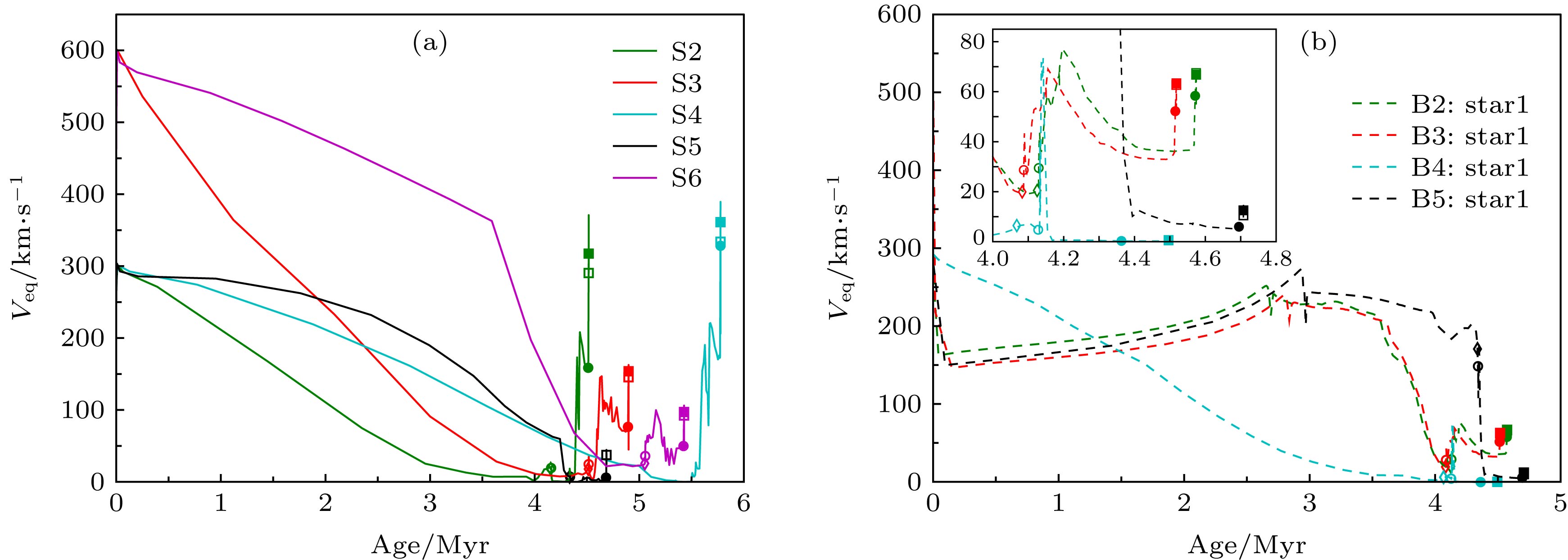
 DownLoad:
DownLoad:
